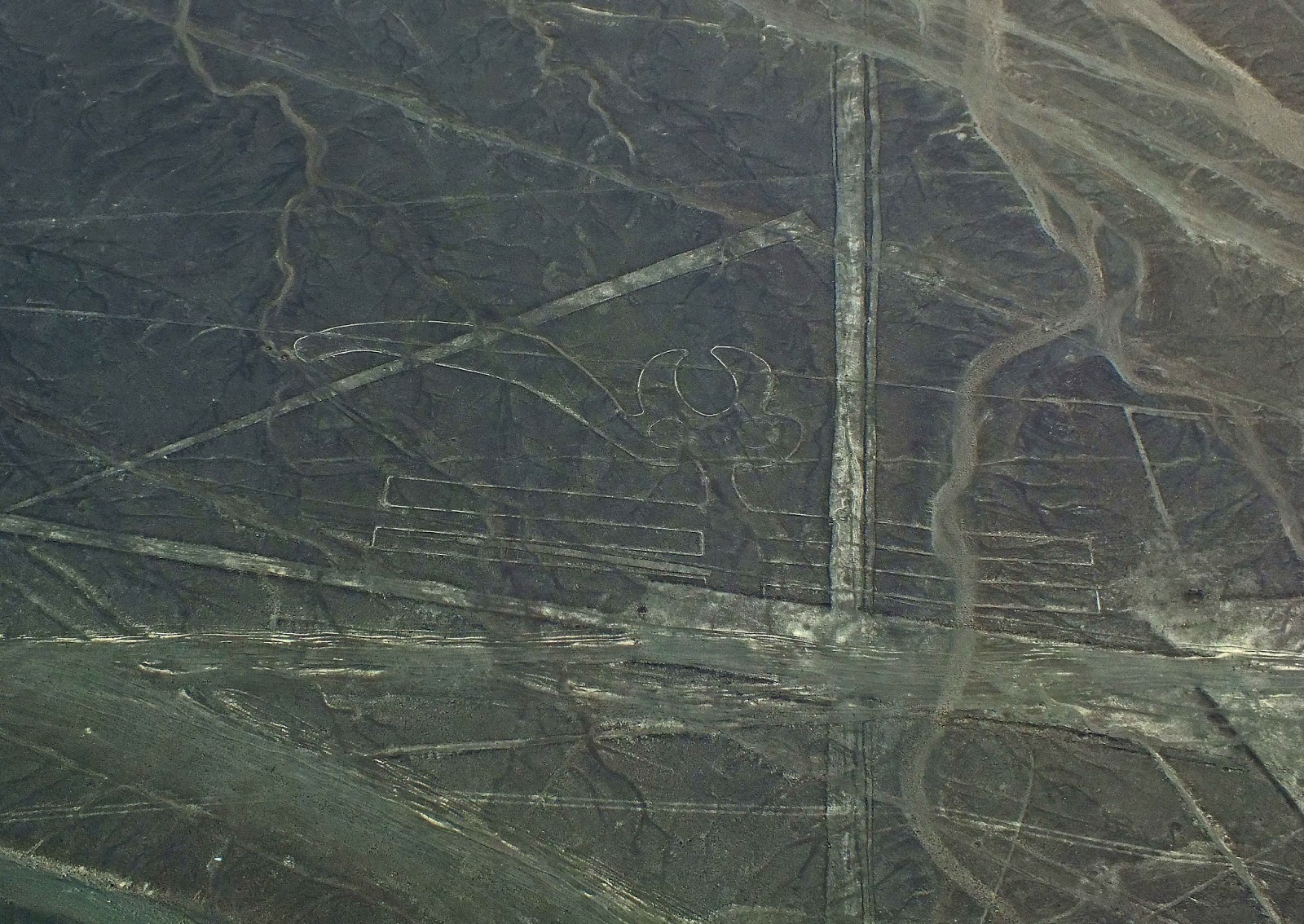
 The Nazca Lines
are a series of ancient geoglyphs located in the Nazca Desert, in southern
Peru. They were designated as a UNESCO World
The Nazca Lines
are a series of ancient geoglyphs located in the Nazca Desert, in southern
Peru. They were designated as a UNESCO World

Heritage Site in 1994. The high,
arid plateau stretches more than 80 kilometres (50 mi) between the towns of
Nazca and Palpa on the Pampas de Jumana about 400 km south of Lima. Although
some local geoglyphs resemble Paracas motifs, scholars believe the Nazca Lines were
created by the Nazca culture between 800 BC and 800 AD. The hundreds of
individual figures range in complexity from simple lines to stylized
hummingbirds, spiders, monkeys, fish, sharks, orcas, and lizards.
 |
| Whale |
 |
| Astronaut | |
The lines are
shallow designs made in the ground by removing the reddish pebbles and
uncovering the whitish/grayish ground beneath. Hundreds are simple lines or
geometric shapes; more than seventy are zoomorphic designs of animals such as
birds, fish, llamas, jaguar, monkey, or human figures. Other designs include phytomorphic
shapes such as trees and flowers. The largest figures are over 200 meters (660
ft) across.
 |
| Monkey | |
 |
| Hummingbird |
Scholars differ
in interpreting the purpose of the designs, but in general they ascribe
religious significance to them. Other theories have been summarized as follows:
"The geometric ones could indicate the flow of water or be connected to
rituals to summon water. The spiders, birds, and plants could be fertility
symbols. Other possible explanations include: irrigation schemes or giant
astronomical calendars."
 |
| Spider |
Due to the dry,
windless, and stable climate of the plateau and its isolation, for the most
part the lines have been preserved. Extremely rare changes in weather may
temporarily alter the general designs. As of recent years, the lines have been
deteriorating due to an influx of squatters inhabiting the lands.
Archeologists, ethnologists, and anthropologists have studied the ancient Nazca
culture to try to determine the purpose of the lines and figures. One
hypothesis is that the Nazca people created them to be seen by their gods in
the sky. Kosok and Reiche advanced a purpose related to astronomy and
cosmology: the lines were intended to act as a kind of observatory, to point to
the places on the distant horizon where the sun and other celestial bodies rose
or set in the solstices.
Many prehistoric
indigenous cultures in the Americas and elsewhere constructed earthworks that
combined such astronomical sighting with their religious cosmology, as did the
later Mississippian culture at Cahokia in present-day United States. Another
example is Stonehenge in England. But Gerald Hawkins and Anthony Aveni, experts
in archaeoastronomy, concluded in 1990 that there was insufficient evidence to
support such an astronomical explanation. Reiche asserted that some or all of
the figures represented constellations. By 1998, Phyllis B. Pitluga, a protégé
of Reiche and senior astronomer at the Adler Planetarium in Chicago, had
concluded that the animal figures were "representations of heavenly
shapes. But she contends that they are not shapes of constellations but of what
might be called counter constellations, the irregular-shaped dark patches
within the twinkling expanse of the Milky Way." Aveni criticized her work
for failing to account for all the details.
 |
| Parrot |
In 1985, the
archaeologist Johan Reinhard published archaeological, ethnographic, and
historical data demonstrating that worship of mountains and other water sources
predominated in Nazca religion and economy from ancient to recent times. He
theorized that the lines and figures were part of religious practices involving
the worship of deities associated with the availability of water, which
directly related to the success and productivity of crops. He interpreted the
lines as sacred paths leading to places where these deities could be worshiped.
The figures were symbols representing animals and objects meant to invoke the
gods' aid in supplying water. The precise meanings of many of the individual
geoglyphs remain unsolved as of 2013.
 |
| Hands or Frog and Tree |
|
Henri Stierlin, a
Swiss art historian specializing in Egypt and the Middle East, published a book
in 1983 linking the Nazca Lines to the production of ancient textiles that
archeologists have found wrapping mummies of the Paracas culture. He contended
that the people may have used the lines and trapezes as giant, primitive looms
to fabricate the extremely long strings and wide pieces of textile that are
typical of the area. By his theory, the figurative patterns (smaller and less
common) were meant only for ritualistic purposes. This theory is not widely
accepted, although scholars have noted similarities in patterns between the
textiles and the Nazca Lines, which they take as sharing in a common culture.
Phyllis Pitluga,
senior astronomer at the Adler Planetarium & Astronomy Museum and a protégé
of Reiche, did computer-aided studies of star alignments. She asserted that the
giant spider figure is an anamorphic diagram of the constellation Orion.
This information was gathered from Wikipedia, while
I was in Nazca, Peru.

 The Nazca Lines
are a series of ancient geoglyphs located in the Nazca Desert, in southern
Peru. They were designated as a UNESCO World
The Nazca Lines
are a series of ancient geoglyphs located in the Nazca Desert, in southern
Peru. They were designated as a UNESCO World 







waw! I know more about this information, may I quote for my homework about Nazca Lines: Mysterious Geoglyphs in Peru
ReplyDelete